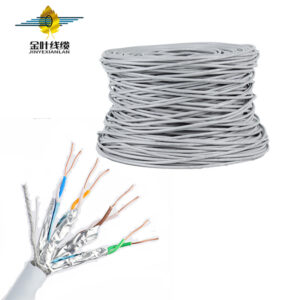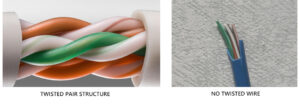Should You Use Shielded Ethernet Cables at Home?
Before you decide to buy shielded Ethernet cables, ask yourself a few important questions:
- Don’t unshielded cables already offer some interference resistance?
- Are there strong sources of electromagnetic interference (EMI) in your home?
- Do all your other network devices fully support shielded cabling?
- Are you aware that installing shielded cables is significantly harder than unshielded ones?
- Is your home network sensitive enough to worry about information leakage?

If you answered “no” to most of these questions, shielded Ethernet cables probably aren’t necessary for you. Let’s dive deeper:
1. Unshielded Cables Also Offer Excellent Interference Protection
There are many types of shielded cables, and it’s easy to get confused when shopping. However, don’t underestimate the capabilities of unshielded cables (usually labeled U/UTP).
Unshielded cables use twisted pair technology, where two conductors are twisted together to cancel out noise and reduce crosstalk. This provides substantial protection against electromagnetic interference (EMI) and radio frequency interference (RFI).
Additionally, the cable’s outer insulation further safeguards signal integrity.
Tip: If a cable lacks twisted pairs, it’s likely a low-quality product. Avoid buying such cables from unregulated shops.
![Example of Twisted Pair Structure]

Low-grade cables often fail to deliver stable network performance, regardless of shielding.
2. Common Sources of Interference at Home
Typical homes do not have strong EMI sources like:
- Industrial motors
- Large-scale generators
- Heavy transformers
- Electromagnetic or nuclear radiation devices
Even high-voltage power lines usually aren’t routed inside homes.
What about 220V/380V home wiring?
While household electrical lines can generate minor EMI, it’s negligible and easily mitigated by proper cable routing practices—such as separating power and data lines or using conduits.
Modern network protocols also have robust error detection and correction features that compensate for minor disturbances.
In fact, many reputable manufacturers recommend unshielded Ethernet cables for home installations.
3. Most Home Devices Don’t Support Shielded Ethernet
Shielded cabling is a system-wide solution, not a standalone upgrade. To benefit from shielded cables, you would need:
- Shielded RJ45 connectors
- Shielded keystone jacks
- Proper grounding of all network devices
- Experienced technicians for correct installation
Without these, installing shielded cables could worsen network performance by creating ground loops or introducing additional noise.
Real-world tests show that improperly installed shielded cables often perform worse than high-quality unshielded cables.
4. Shielded Cable Installation is Much More Difficult
Shielded cables are:
- Thicker and heavier
- Harder to bend or pull through conduits
- More prone to installation errors if not handled carefully
Electricians often charge higher fees for shielded cable installation due to the extra labor and difficulty involved.
Moreover, shielded cables complicate future maintenance and upgrades. Replacing them later can be a costly headache.
5. Is Your Home Network Really That Sensitive?
Unless you are storing classified government data at home, the chances of electromagnetic eavesdropping are virtually zero.
Even if someone wanted to tap into your network, they would likely target your wireless signals or networked devices—not your Ethernet cables.
Rest easy—you’re not a spy movie character!
Conclusion: Shielded Ethernet Cables Are Not Needed for Most Homes
For the vast majority of home users:
- Shielded cables are unnecessary
- They add costs without real benefits
- They can cause network problems if installed improperly
Recommendation: Stick with high-quality unshielded Ethernet cables for your home network!
FAQ
What is the difference between shielded and unshielded Ethernet cables?
Shielded Ethernet cables have an extra layer of metal shielding to protect against external electromagnetic interference (EMI), while unshielded cables rely on twisted pair technology to naturally resist interference. In most home environments, unshielded cables are sufficient.
When should I use shielded Ethernet cables?
Shielded cables are best used in industrial environments with high levels of EMI, such as factories, hospitals with MRI equipment, or near large electrical machinery.
Will shielded Ethernet cables improve my internet speed at home?
No. Shielded cables do not directly improve internet speed. Network speed depends primarily on your internet service plan, network devices (router, modem, switch), and overall system design.
Can shielded Ethernet cables cause problems?
Yes. If shielded cables are not properly grounded, they can cause network instability, increased latency, or even data transmission errors.
Can I mix shielded and unshielded Ethernet cables at home?
Technically yes, but it’s not recommended. Mixing can introduce grounding issues and inconsistent network performance. It’s best to maintain a consistent cabling standard across your entire network.
Are shielded cables faster than unshielded cables?
No. Shielding mainly protects against interference; it does not directly affect transmission speed. Factors like cable category (e.g., Cat6, Cat6A) and installation quality have a greater impact on speed.
When should I consider using shielded cables at home?
If your home is located near high-power electrical infrastructure, or if you’re building a dedicated server room with multiple devices densely packed together, shielded cables may offer marginal benefits.
Does cable length affect the need for shielding?
Not usually. Ethernet standards (e.g., 100 meters for Cat6) already account for signal attenuation. Shielding becomes more important with long runs only if strong external interference sources are present.
Wondering if you need shielded Ethernet cables at home? Discover the pros, cons, and why high-quality unshielded cables are usually the best choice for most home networks.
- [Best Ethernet Cables for Home Use in 2025]
- [How to Install Ethernet Cables Properly at Home]
- [Common Network Setup Mistakes and How to Avoid Them]
- Wikipedia: Twisted Pair Ethernet Cables
- IEEE Guide to Ethernet Shielding Best Practices
